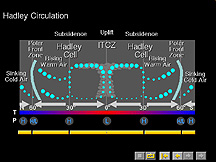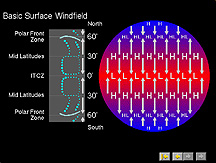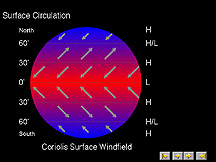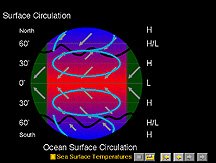 Human Environmental Cycle
Human Environmental Cycle
...to Geog 111 Main Page and Course Description
...to Geog 111 Syllabus
...to Geog 111 Course Schedule and Lecture Outlines
...to Geog 111 Course Project
General Comments on Exam 1:
The exam consists of about 40% multiple choice/true false questions, about 20% short answer and 40% label the diagram questions.
The following review touches on relevant concepts, definitions, ideas, etc. You will, of course, have to refer back to your notes and the lecture outlines and appropriate parts of the readings in McKnight and Middleton for the details. You are expected to know what was presented in lecture (which is more than is in the lecture outlines on the WWW) and you should expect to use the assigned readings to back up the material discussed in lecture. However, I do not expect you to know things from the readings that were not presented in lecture.
Students who have done well on my exams in the past have taken the time to rewrite their notes along with the lecture outlines, and have clarified missing details from their notes by contacting me (in person or via email) before the exam. Simply glancing over lecture outlines from the course WWW is not the best way to study for this course.
Do contact me (email is best) if you have any questions or problems in preparing for the exam: jbkrygier@owu.edu
Introduction to Earth's Physical Environment
1. Defining Geography
Geography: definitions
2. Introduction to Earth's Physical Environment
2a. The Solar System
2b. Size and Shape of Earth
2c. The Geographic Grid
Earth Coordinate Systems: arbitrary, graph-like grids imposed on the Earth
2d. Earth Movements
Two basic Earth movements are vital
2e. Earth's Seasons
3. Classifying the Natural World: Environmental Spheres, Ecosystems, and Biomes
3a. The Environmental Spheres
1. Lithosphere: Greek (litho) = stone
2. Atmosphere: Greek (atmo) = air
3) Hydrosphere: Greek (hydro) = water
4) Biosphere: Greek (bio) = life
The four spheres are not discrete and separate, but intermingled
3b. Ecosystems and Biomes
Ecosystem: a group of environmental characteristics which define a particular area; the totality of interactions among organisms and the environment in the area of consideration;elements from all the earthly spheres
Classify according to the relationship between climate (atmosphere) and the biosphere: biomes
Biomes: large areas of the earth can be categorized as relatively distinctive, with particular climate, animals, plants: a large, recognizable assemblage of plants and animals in functional interaction with its environment
Major World Biomes:McKnight fig 11.27: Major World Biomes
Note: particular world biomes are discussed briefly in Middleton Ch. 1 and in McKnight Ch. 11 (as well as the lecture outlines).
4. Natural Cycles
Natural cycles are cycles of matter in the natural world: where molecules are formed and re-formed by chemical and biological reactions, manifested as physical changes in the matter
4a. The Hydrologic Cycle
4b. The Carbon Cycle
What is most important is a sense of how natural systems work, and that humans modify these systems, and that one of the reasons we don't have a sense of the effects of our modification of these natural systems is that they are often out of sync with our particular time and location
5. Time and Space and Environmental Change
5a. Time and Environmental Change
Earth age: 4600 million years
Time scale chosen to study natural systems effects understanding
Dynamic equilibrium: input and output of matter in natural systems is balanced, but there are shorter term fluctuations: short term fluctuations, but longer term stability
Feedback in a natural system: negative feedback vs. positive feedback
Change in natural environment consists of
5b. Spatial Scales and Environmental Change
Spatial scale also effects our understanding of environmental change
Conclusions: The State of our Knowledge
1. Human Environmental Relations: Introduction
1a. Environmental Determinism: environment overpowers and shapes culture
1b. Human/Cultural Determinism: culture overpowers and shapes the environment
1c. Human Environmental Interaction
 Human Environmental Cycle
Human Environmental Cycle
2. Human Environmental Relations: Examples
Examples: climate, vegetation, landforms
2a. Climate
Climate influences humans and cultures
However, people have learned to adapt to and even modify the climate
2b. Vegetation
Humans and cultures have been shaped by vegetation
But humans and cultures can adapt and change vegetation
2c. Landforms
Landforms shape human and cultural activities
Yet, humans and cultures adapt and change landforms
2d. Human Environmental Interaction: The Centralia Mine Fire
Mine fire, underground in Centralia Pennsylvania
3. Human Perspectives on the Physical Environment
There are many different ways of understanding the relationship between the environment and humans: vary over time, through space. In all cases these are human concepts: they are not natural to the world
Resources: anything in the natural world that is useful to humans; a cultural appraisal of the natural world, as different cultures (and the same cultures at different times) assume certain things to be resources and others not
4. Human Forces Behind Environmental Issues
Interactions between humans and natural environment results from our attempts to satisfy real and perceived needs and wants
Human behavior leads to
5. Human Induced Balances
6. Interest in Environmental Issues
Human interest in environmental issues: not recent
Middleton table 2.4: 20th century Western Environmental Thought
Technocentric approaches: technology and economics can be used to solve environmental problems; relatively easy to solve environmental problems without major social or economic or political change
Ecocentric approaches: deep rooted problems with ethics and morals lead to environmental problems; can't easily be fixed with economic or technological means; must change our world views
7. Sustainable Development
Sustainable development: an attempt a compromise between economic development, the creation of wealth, and the exploitation of natural resources on one hand, and stewardship and conservation of natural resources and the natural environment on the other
7a The Idea of Sustainable Development
Origins in a Report: World Conservation Strategy (1980)
Developed further by the Brundtland Commission: UN 1983
Six principles of sustainable development (from these two reports)
Sustainable development: "development which meets the needs of the present without compromising the ability of future generations to meet their own needs" (World Commission on Environment and Development, 1987)
7b. Valuing Environmental Resources
ex) Environmental Economics: the world is based on money and costs and benefits and thus treat the environment in this manner
7c. Growth and Development
Basic belief of sustainable development: growing influence of idea that we can improve human lives and society (development) with very slow or no economic growth by being more efficient and careful with our use of resources
Portraying the Earth
1. The Nature of Maps
Map: a two dimensional representation of the spatial distribution of selected phenomena; usually components of the human or physical landscape
A scaled drawing of a portion of a landscape, representing the area at reduced scale and showing only selected data
1a. A Matter of Scale
Map scale
Map Scale Types
graphic scale: line or bar on map represents some set distance
word scales: describes the scale of the map in words
fractional scales: a proportion between map distance and Earth distance
Large and Small Scale Maps and examples of each
1b. Map Graticule
In order to locate phenomena on the earth we need some way to locate that phenomena: a system of location: latitude / longitude
1c. Map Projections
Problem: have to flatten out the Earth to get it on a flat surface
Inevitable distortions occur when you project a map
1d. Map Generalization: using judgement in the elimination of detail and
reduction of the number of features on the original map
1e. Map Content: reference vs. thematic
reference maps: general use (for many purposes), focus on and emphasize the location of things in the environment - many different purposes; like a general world atlas or encyclopedia
thematic maps: particular use: focus on and emphasize the spatial patterns of one or several human or environmental phenomenon
1f. Map Symbolization
symbol: A thing representing something else because of relationship, association, convention, or resemblance.
2. Developments in Mapping: Computer aided Mapping (skip this section)
2a. Global Positioning System (GPS)
24 satellites around Earth, transmitting locational (positional) information back to earth
2b. Remote Sensing
Any measurement or acquisition of information by a recording device that is not in physical contact with the Earth's surface (air photo, satellite image)
2c. Geographic Information System
Automated systems for the capture, storage, retrieval, analysis, and display of spatial data
Important: GIS is digital maps linked to databases
Introduction to the Atmosphere
air: same as atmosphere
dimensions of the atmosphere
1. Composition of the Atmosphere
1a. The Gasses
1b. The Particles
2. Vertical Structure of the Atmosphere
2a. Atmospheric Temperature
Text) McKnight fig 3.5
2b. Atmospheric Pressure
2c. Atmospheric Composition
3. Weather and Climate
4. Elements of Weather and Climate
Four elements as the basis of weather and climate:
Changes in the four elements of weather and climate are driven by several controls
4a. Latitude
4b. General Atmospheric Circulation: Hadley Circulation
 Image from Animation
Image from Animation
 Image from Animation
Image from Animation
 Image from Animation
Image from Animation
4c. General Circulation of Oceans
 Image from Animation
Image from Animation
 Image from Animation
Image from Animation
4d. Distribution of land and water
4e. Elevation of Landforms
4f. Topographic Barriers
These six factors drive day to day weather and longer term climate patterns
Introduction to the Hydrosphere
1. The Nature of Water
General characteristics:
Processes which cause it to change from one state to another
2. The Hydrologic Cycle
Important Diagram) McKnight fig 9.5
Residence Times: water remains for variable amounts of times at different stages in the hydro cycle
Seven components of the hydrological cycle and corresponding physical processes
2a. Surface to Air Water Movement
Two primary sources:
2b. Air to Surface Water Movement
Processes of condensation and precipitation
Condensation: what is it and how does it work?
Precipitation: what is it and how does it work?
Two processes result in precipitation
2c. Movement on and Beneath Earth's Surface
Geographic imbalances:
Due to advection: what is it?
Surface run-off, subsurface flow
2d. The Oceans
Characteristics of Ocean Waters
Movement of Ocean Waters
2e. Permanent Ice
2f. Surface Waters
2g. Underground Water
E-mail: jbkrygier@owu.edu
...to Geog 111 Main Page and Course Description
...to krygier teaching page.
...to krygier top page.